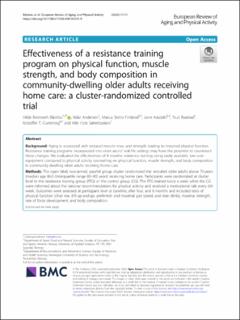Effectiveness of a resistance training program on physical function, muscle strength, and body composition in community-dwelling older adults receiving home care: A cluster-randomized controlled trial
Bårdstu, Hilde Bremseth; Andersen, Vidar; Fimland, Marius Steiro; Aasdahl, Lene; Raastad, Truls; Cumming, Kristoffer Toldnes; Sæterbakken, Atle Hole
Peer reviewed, Journal article
Published version
Permanent lenke
https://hdl.handle.net/11250/2774599Utgivelsesdato
2020Metadata
Vis full innførselSamlinger
Originalversjon
European Review of Aging and Physical Activity. 2020, 17 . 10.1186/s11556-020-00243-9Sammendrag
Background: Aging is associated with reduced muscle mass and strength leading to impaired physical function. Resistance training programs incorporated into older adults’ real-life settings may have the potential to counteract these changes. We evaluated the effectiveness of 8 months resistance training using easily available, low cost equipment compared to physical activity counselling on physical function, muscle strength, and body composition in community-dwelling older adults receiving home care. Methods: This open label, two-armed, parallel group, cluster randomized trial recruited older adults above 70 years (median age 86.0 (Interquartile range 80–90) years) receiving home care. Participants were randomized at cluster level to the resistance training group (RTG) or the control group (CG). The RTG trained twice a week while the CG were informed about the national recommendations for physical activity and received a motivational talk every 6th week. Outcomes were assessed at participant level at baseline, after four, and 8 months and included tests of physical function (chair rise, 8 ft-up-and-go, preferred- and maximal gait speed, and stair climb), maximal strength, rate of force development, and body composition. Results: Twelve clusters were allocated to RTG (7 clusters, 60 participants) or CG (5 clusters, 44 participants). The number of participants analyzed was 56–64 (6–7 clusters) in RTG and 20–42 (5 clusters) in CG. After 8 months, multilevel linear mixed models showed that RTG improved in all tests of physical function and maximal leg strength (9–24%, p = 0.01–0.03) compared to CG. No effects were seen for rate of force development or body composition. Conclusion: This study show that resistance training using easily available, low cost equipment is more effective than physical activity counselling for improving physical function and maximal strength in community-dwelling older adults receiving home care.
